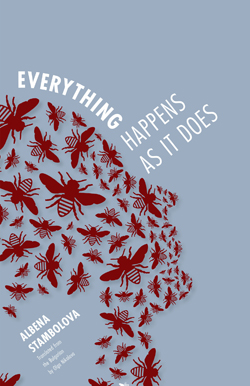Everything Happens As It Does
by Albena Stambolova, translated by Olga Nikolova
reviewed by Greg Harris
Carl Jung, in “On the Relation of Poetry and Analytic Psychology,” writes that certain mythological situations appear in literature “characterized by a peculiar emotional intensity”; these archetypal schema are like a “deeply graven riverbed in the psyche, in which waters of life, instead of flowing on as before in a broad but shallow stream, suddenly swell into a mighty river.” It is just such an effect that Bulgarian author Albena Stambolova reaches for in Everything Happens As It Does, the first of her novels to be translated into English, lucidly rendered in this edition by Olga Nikolova.
The book is a strange and beautiful experiment in marrying fairy tale and naturalism. It begins with a mute boy who communes mainly with computers and bees and ends with the passing of his sister/mother/lover Maria, a witch-figure whose inner workings defy analysis while she’s alive, and whose dead body resists even the interpretive acumen of her pathologist ex-husband, a man whose “job consisted of finding causes.” He is helpless before “cases like this—one in how many . . . no known cause of death.”
In between, the novel is populated with characters who flicker between realism and myth: the gallery artist whose process demands such total, frigid absorption that her penthouse apartment spills an icy wind; a brother-sun and sister-moon whose twinned alienness (he acts, goes to university; she reflects, darkly) is only resolved through incest. Much of the writing is lovely and, in the mode of Garcia Marquez or Murakami, prevents the reader from drawing lines between the symbolic and actual. Maria, for instance, while subject to circumstances as normal as hiring a divorce lawyer, is also a witch-like creature with eyes of fog in an opalescent, impossible body. No one can refuse her or even ask questions; her hair billows around her “like night wind and flapping wings.” Her first husband experiences himself turning into “a boomerang, always meekly landing at her feet, no matter what he thought, no matter what he did.”
The plot, in fact, boils down to the question of how to solve a problem like Maria, and no one can. Up to the very hour of her death, people are helplessly caught in scenarios they don’t understand or agree with, the meanings of which escape them. “Some words could be used . . . to describe what had happened,” Maria’s son thinks, “but so what? Such words could form sentences full of pathos, yet they did not lead to any clarity or illumination.” It is only once Maria dies that anything thaws or changes.
This thaw takes place for most of the characters that same night, which is a Christmas night. “The spell was lifted” from the gallery artist’s penthouse, and a party inspired by the union of Maria’s twin children wakes the artist from her frozen state “incredulous that a turn of fortune . . . made it seem worthwhile to have hibernated all this time.” Her parents—minor characters to this point—afterwards make love, with “no worry about anything; there was only this, here, where everything happened as it did.”
This is the novel’s theme, and title, and also its climax and main action, if words like “climax” and “action” apply to something as limitedly dramatic as a carefully constructed mobile. The workings of Everything Happens As It Does are precisely the inverse of E. T. A. Hoffman’s Nutcracker, that other deeply strange symbolic-psychological work set at Christmas. The Nutcracker shakes the snowglobe of an ordinary Christmas scene and finds an unsettling pageantry of the psychosexual; Everything Happens, which from its beginning presents unsettled psychosexual elements, dissolves back to ordinary life.
But in seeing this inverse magic, we see the problem with the novel, whose characters are, for the most part, static, brightly colored miniatures—symbols more than people, or, if people, symbolically (and obscurely) motivated. Jung notes in his essay that the artist has to deal with the particular, that only occasionally do archetypes “sound forth like a chord.” Everything Happens, for all its strengths, is a lesson in how aiming for the resonances risks missing the primary note.
Published on July 10, 2014

